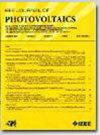利用硅 LSI 设计的光伏发电纳安培电流源
IF 2.5
3区 工程技术
Q3 ENERGY & FUELS
引用次数: 0
摘要
在这项研究中,我们展示了一种利用半开路光伏电池自供电的纳安培电流源。这种电池是通过在光伏电池上连接一个大电阻来设计的,从而能够输出非常小的电流。通过改变负载电阻,可以线性改变输出电流。我们进行了数值模拟来验证这一概念,并讨论了负载电阻、电池面积和光源对输出电流的影响。我们的实验表明,使用不同的光源可以获得足够稳定的电流输出,输出电流与负载电阻之间呈反向线性关系。我们预计需要足够的光电流来稳定输出电流。本文章由计算机程序翻译,如有差异,请以英文原文为准。
Photovoltaic-Generated Nanoampere Current Source Designed on Silicon LSIs
In this study, we demonstrates a self-powered self-generated nanoampere current source using a semi-open-circuit photovoltaic cell. This cell was designed by connecting a large resistance to a photovoltaic cell that enabled the output of a very small current. By changing load resistances, the output current can be linearly modified. We have conducted the numerical simulations to validate the concept and discussed effects of load resistance, cell area and light source to output current. Our experiment demonstrated that a sufficiently stable current output can be obtained using different light sources, and inversely linear relationship between the output current and the load resistance was obtained. We anticipate that sufficient photocurrent would be required to stabilize the output current.
求助全文
通过发布文献求助,成功后即可免费获取论文全文。
去求助
来源期刊

IEEE Journal of Photovoltaics
ENERGY & FUELS-MATERIALS SCIENCE, MULTIDISCIPLINARY
CiteScore
7.00
自引率
10.00%
发文量
206
期刊介绍:
The IEEE Journal of Photovoltaics is a peer-reviewed, archival publication reporting original and significant research results that advance the field of photovoltaics (PV). The PV field is diverse in its science base ranging from semiconductor and PV device physics to optics and the materials sciences. The journal publishes articles that connect this science base to PV science and technology. The intent is to publish original research results that are of primary interest to the photovoltaic specialist. The scope of the IEEE J. Photovoltaics incorporates: fundamentals and new concepts of PV conversion, including those based on nanostructured materials, low-dimensional physics, multiple charge generation, up/down converters, thermophotovoltaics, hot-carrier effects, plasmonics, metamorphic materials, luminescent concentrators, and rectennas; Si-based PV, including new cell designs, crystalline and non-crystalline Si, passivation, characterization and Si crystal growth; polycrystalline, amorphous and crystalline thin-film solar cell materials, including PV structures and solar cells based on II-VI, chalcopyrite, Si and other thin film absorbers; III-V PV materials, heterostructures, multijunction devices and concentrator PV; optics for light trapping, reflection control and concentration; organic PV including polymer, hybrid and dye sensitized solar cells; space PV including cell materials and PV devices, defects and reliability, environmental effects and protective materials; PV modeling and characterization methods; and other aspects of PV, including modules, power conditioning, inverters, balance-of-systems components, monitoring, analyses and simulations, and supporting PV module standards and measurements. Tutorial and review papers on these subjects are also published and occasionally special issues are published to treat particular areas in more depth and breadth.
 求助内容:
求助内容: 应助结果提醒方式:
应助结果提醒方式:


